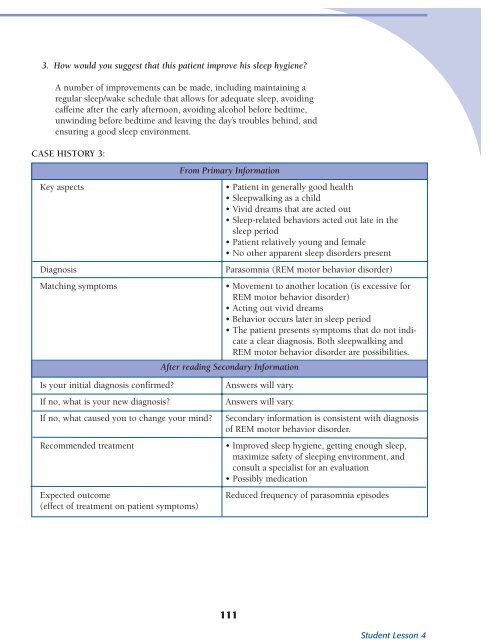Biological - NIH Office of Science Education - National Institutes of ...
Biological - NIH Office of Science Education - National Institutes of ...
Biological - NIH Office of Science Education - National Institutes of ...
Create successful ePaper yourself
Turn your PDF publications into a flip-book with our unique Google optimized e-Paper software.
3. How would you suggest that this patient improve his sleep hygiene?<br />
A number <strong>of</strong> improvements can be made, including maintaining a<br />
regular sleep/wake schedule that allows for adequate sleep, avoiding<br />
caffeine after the early afternoon, avoiding alcohol before bedtime,<br />
unwinding before bedtime and leaving the day’s troubles behind, and<br />
ensuring a good sleep environment.<br />
CASE HISTORY 3:<br />
Key aspects<br />
Diagnosis<br />
Matching symptoms<br />
From Primary Information<br />
• Patient in generally good health<br />
• Sleepwalking as a child<br />
• Vivid dreams that are acted out<br />
• Sleep-related behaviors acted out late in the<br />
sleep period<br />
• Patient relatively young and female<br />
• No other apparent sleep disorders present<br />
Parasomnia (REM motor behavior disorder)<br />
• Movement to another location (is excessive for<br />
REM motor behavior disorder)<br />
• Acting out vivid dreams<br />
• Behavior occurs later in sleep period<br />
• The patient presents symptoms that do not indicate<br />
a clear diagnosis. Both sleepwalking and<br />
REM motor behavior disorder are possibilities.<br />
After reading Secondary Information<br />
Is your initial diagnosis confirmed?<br />
If no, what is your new diagnosis?<br />
If no, what caused you to change your mind?<br />
Recommended treatment<br />
Expected outcome<br />
(effect <strong>of</strong> treatment on patient symptoms)<br />
Answers will vary.<br />
Answers will vary.<br />
Secondary information is consistent with diagnosis<br />
<strong>of</strong> REM motor behavior disorder.<br />
• Improved sleep hygiene, getting enough sleep,<br />
maximize safety <strong>of</strong> sleeping environment, and<br />
consult a specialist for an evaluation<br />
• Possibly medication<br />
Reduced frequency <strong>of</strong> parasomnia episodes<br />
111<br />
Student Lesson 4

















